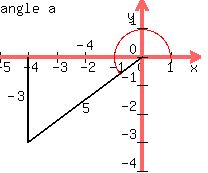Draw a picture of the two given angles in their
respective quadrants.
Since  , make the opposite side
of the angle 'a' nearest the x-axis be the numerator of -3/5,
which is -3, and the hypotenuse be the denominator of -3/5,
which is 5.
Since
, make the opposite side
of the angle 'a' nearest the x-axis be the numerator of -3/5,
which is -3, and the hypotenuse be the denominator of -3/5,
which is 5.
Since  , make the opposite side
of the angle 'B' nearest the x-axis be the numerator of -5/12,
which is -5, and the adjacent be the denominator of -5/12,
which is 12. Use the Pythagorean theorem to calculate the
adjacent side of angle 'a' to be -4 (negative because it goes
to the left. Also use the Pythagorean theorem to calculate the
hypotenuse of angle 'a' to be 13 (positive because the hypotenuse
is the TERMINAL SIDE of the angles which is ALWAYS taken positive.
, make the opposite side
of the angle 'B' nearest the x-axis be the numerator of -5/12,
which is -5, and the adjacent be the denominator of -5/12,
which is 12. Use the Pythagorean theorem to calculate the
adjacent side of angle 'a' to be -4 (negative because it goes
to the left. Also use the Pythagorean theorem to calculate the
hypotenuse of angle 'a' to be 13 (positive because the hypotenuse
is the TERMINAL SIDE of the angles which is ALWAYS taken positive.

 Now use an identity for
Now use an identity for



 <--given
<--given
 Substitute those values in
Substitute those values in
 and simplify. You finish.
Edwin
and simplify. You finish.
Edwin